UX Information Architecture (IA) is the discipline of organizing content in a way that helps users easily navigate through and find information on digital platforms.
Historically, this practice, called information architecture, has evolved significantly with the rise of the internet, becoming crucial for UX designers and content managers to prevent chaos on the web. This article defines information architecture and its main elements and illustrates how it enhances user experience.
What Is Information Architecture?
Information Architecture is the invisible backbone that makes websites and apps feel natural to use. Think of it as the blueprint for organizing content - like how a well-designed library helps you find any book without confusion.
IA shapes how users move through your digital space. It determines whether someone finds what they need in seconds or gives up in frustration. Every navigation menu, category label, and content relationship stems from information architecture decisions.
Information Architecture
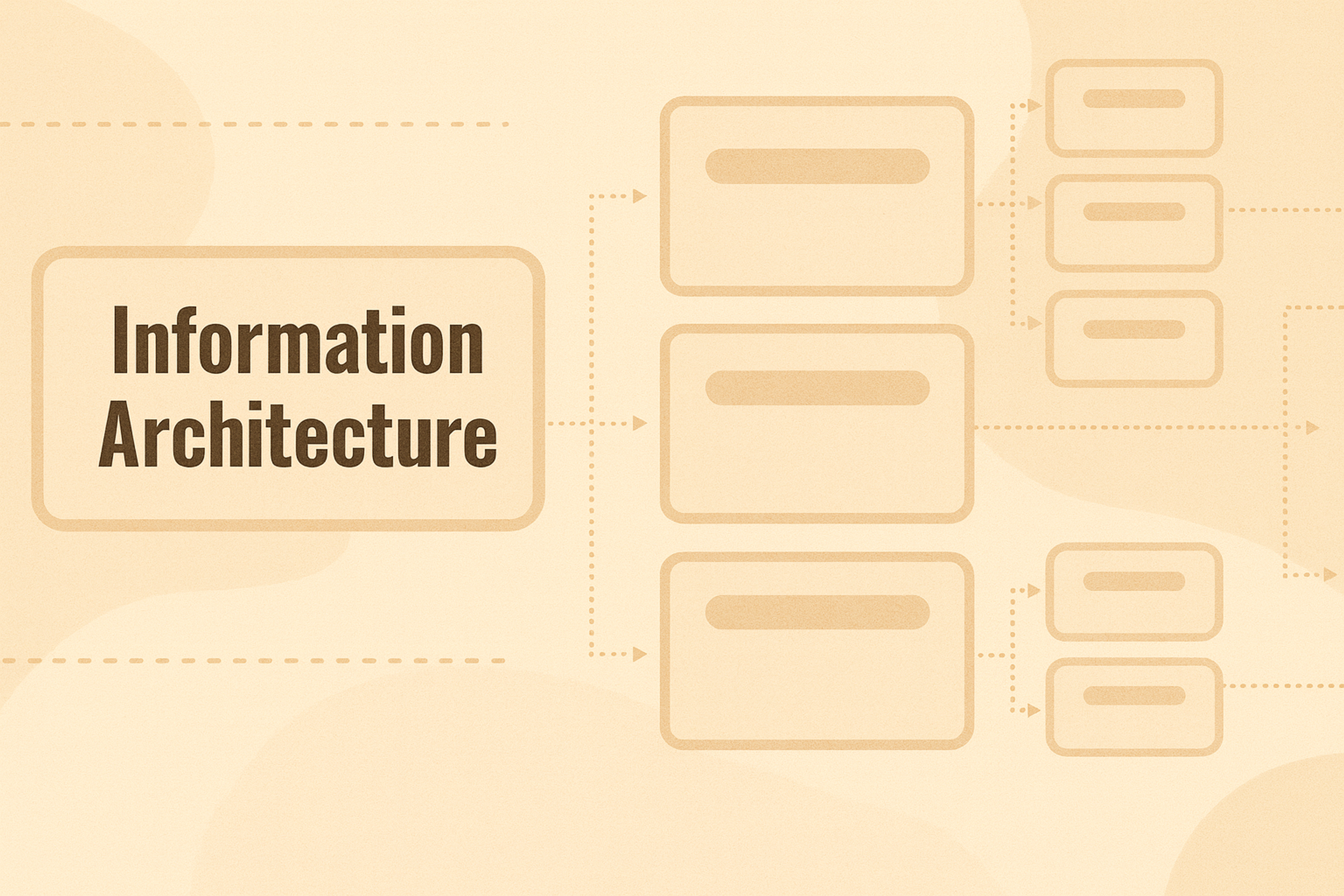
This discipline emerged from library science but evolved into a core UX practice. Modern IA combines user psychology with content strategy. It answers critical questions: How should information connect? What paths make sense to users? Where should important content live?
Good information architecture feels invisible. Users navigate effortlessly without thinking about the underlying structure. Bad IA creates digital chaos - users get lost, abandon tasks, and never return.
4 Types of Information Architecture
Hierarchical
Hierarchical IA organizes content like a family tree. Broad categories branch into specific subcategories, creating clear parent-child relationships that users can predict.
This approach works best for large websites with diverse content. E-commerce sites use hierarchical structures - Electronics splits into Computers, then Laptops, then specific brands and models. Each level gets more specific.
Users benefit from predictable navigation patterns. They learn that drilling down reveals more detailed options while moving up shows broader categories. This mental model aligns with how people naturally organize information.
The tree structure also scales well. Adding new content means finding the right branch rather than restructuring everything. This makes hierarchical IA perfect for growing businesses and expanding content libraries.
Sequential
Sequential IA guides users through predetermined steps. Like following a recipe, each stage builds on the previous one, creating logical progression toward a goal.
Checkout processes exemplify sequential architecture. Users move from cart review to shipping details to payment information. Each step prepares them for the next while preventing overwhelming choice paralysis.
Educational platforms rely heavily on sequential IA. Course modules progress from basic concepts to advanced applications. Students complete prerequisites before accessing complex material, ensuring proper knowledge building.
Matrix
Matrix IA uses multiple categories simultaneously, letting users filter and explore content across different dimensions. Imagine a spreadsheet where both rows and columns provide meaningful organization.
Product catalogs showcase matrix architecture effectively. Users might filter by price range, brand, features, and ratings simultaneously. Each filter narrows results while maintaining multiple exploration paths.
This structure works when users have diverse needs and preferences. Real estate sites use matrix IA - properties filtered by location, price, size, and amenities. Different users prioritize different attributes.
Network
Network IA creates web-like connections between related content. Instead of rigid hierarchies, content links organically based on relevance and user interests.
Social media platforms exemplify network architecture. Posts connect through hashtags, mentions, shared interests, and social relationships. Users discover content through multiple pathways rather than fixed categories.
This approach mirrors how people naturally think and associate ideas. Wikipedia uses network IA - articles link to related concepts, creating knowledge webs that support diverse learning paths.
Why Is Information Architecture Important in Web and App Design?
Without solid IA, digital products become digital nightmares. Users arrive with goals but face confusing navigation, unclear labels, and dead ends. They leave frustrated, and your business suffers.
Information architecture creates order from potential chaos. It transforms overwhelming content libraries into navigable, logical systems. Users find what they need quickly, complete tasks successfully, and return for more.
The business impact is measurable. Poor IA increases bounce rates as confused users abandon sites immediately. Support costs rise when people can't find basic information. Conversion rates drop when purchase processes feel unclear.
Why AI Matters
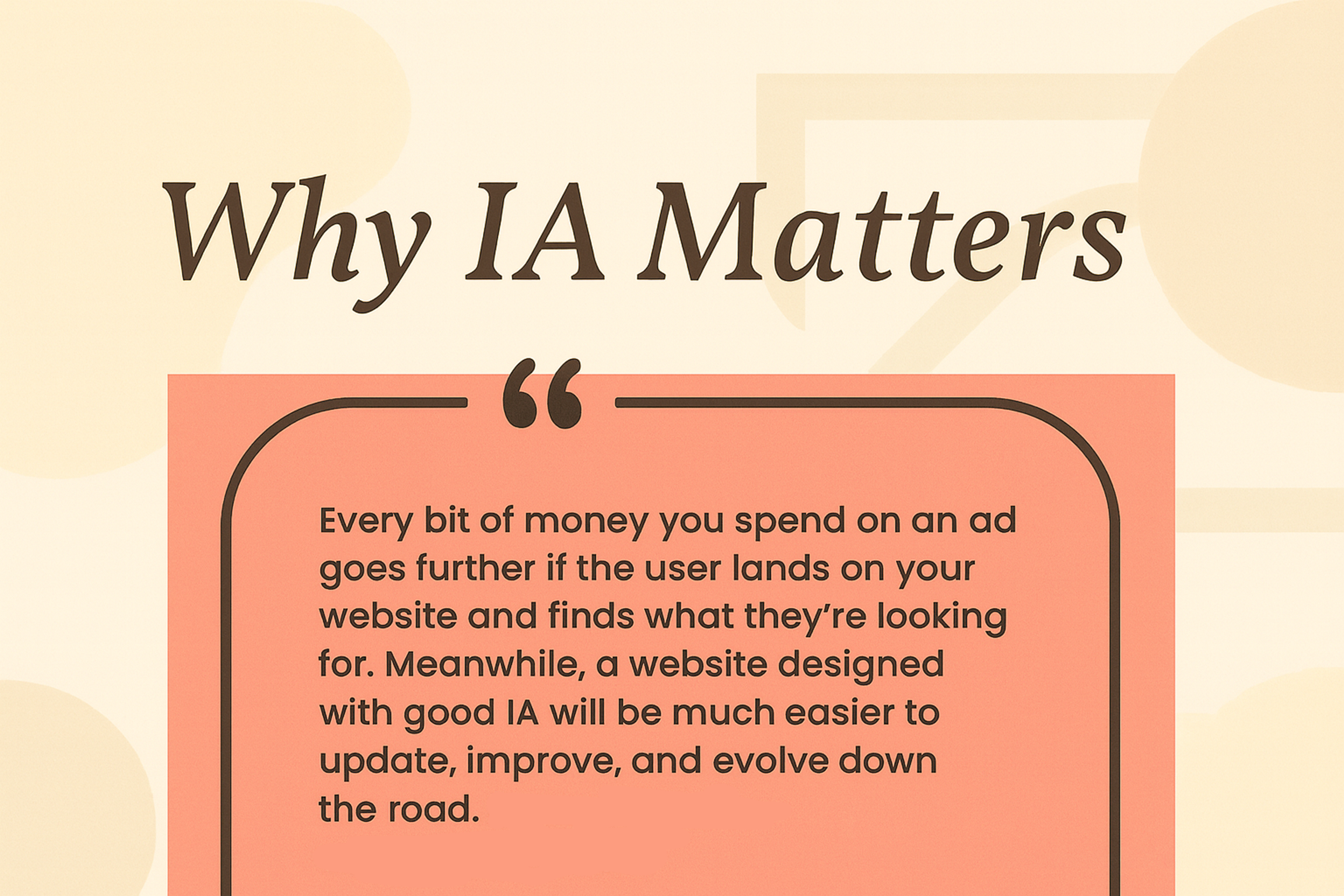
Good IA drives engagement and satisfaction. Users spend more time exploring when navigation feels natural. They complete more tasks when paths are obvious. They recommend products that feel intuitive to use.
IA also enables scalability. Well-structured systems accommodate new content without breaking existing patterns. Growing businesses can expand their digital presence while maintaining user-friendly experiences.
Information Architecture vs Sitemap vs Data Architecture
These three concepts often get confused, but each serves distinct purposes in digital product development.
Information Architecture takes the broadest view. It encompasses content organization, user navigation patterns, labeling systems, and relationship hierarchies. IA considers the entire user experience of finding and using information.
A sitemap provides a focused structural overview. Think of it as a blueprint showing how pages connect and relate. Sitemaps help development teams understand technical requirements and page relationships, but they don't address user behavior or content strategy.
Information Architecture vs Sitemap
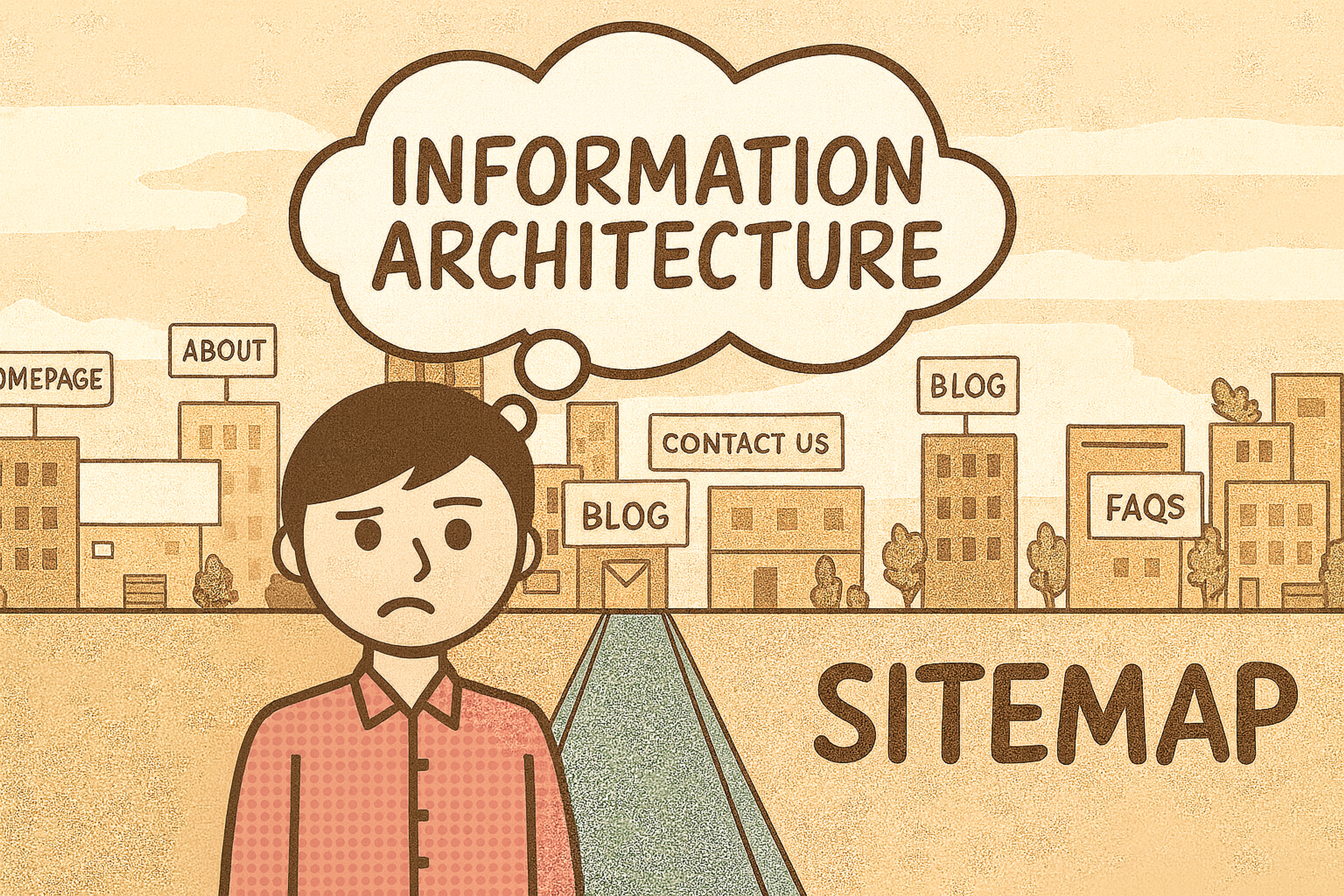
Data Architecture operates behind the scenes. It manages how information gets stored, processed, and retrieved in databases and systems. Data architects ensure information flows efficiently between technical components, regardless of user experience.
The relationships matter for project success. Information architects design user-facing organization. Data architects build technical infrastructure to support that organization. Sitemaps bridge these perspectives by documenting the structural implementation.
What Are the 5 Key Steps in Information Architecture Design?
Creating effective IA requires systematic research and design. These five steps transform user needs into functional information structures.
User Research
IA begins with understanding your audience. Who uses your product? What motivates them? How do they think about and organize information in their daily lives?
User research reveals mental models - the internal frameworks people use to understand systems. When your IA aligns with user mental models, navigation feels intuitive. When it conflicts, users struggle and abandon tasks.
Research methods include user interviews, surveys, and observation sessions. Card sorting exercises reveal how people naturally group and label content. Tree testing shows whether proposed structures support user tasks effectively.
Content inventory runs parallel to user research. Catalog existing content, identify gaps, and understand what information users actually need. This prevents designing beautiful structures for irrelevant content.
Analysis
Research data needs careful analysis to reveal actionable patterns. Look for common user goals, shared mental models, and consistent content needs across your audience.
Create user personas that capture key audience segments. These aren't demographic profiles but behavioral archetypes that guide design decisions. How does each persona approach information seeking? What paths do they prefer?
Content analysis identifies relationships and hierarchies. Which topics connect naturally? What information serves as prerequisites for other content? How do business goals align with user needs?
Gap analysis reveals what's missing. Users might need information that doesn't exist yet. Existing content might lack proper organization or labeling. These insights guide both IA design and content strategy.
Design
With research and analysis complete, you can design the actual information architecture. This involves creating navigation systems, content hierarchies, and labeling schemes that support user goals.
Start with high-level organization. How should major content areas relate? What top-level categories make sense to users? How will people move between different sections of your system?
Design navigation patterns that feel predictable. Users should understand where they are, where they can go, and how to return to familiar places. Consistent patterns reduce cognitive load and increase confidence.
Label content using language your users understand. Avoid internal jargon and technical terminology. Test labels with real users to ensure clarity and avoid misunderstandings.
Implementation
Implementation transforms IA designs into functional systems. This involves creating wireframes, prototypes, and development specifications that guide technical implementation.
Work closely with development teams to ensure technical feasibility. Some IA concepts might require complex database structures or sophisticated search algorithms. Early collaboration prevents late-stage compromises.
Content creation follows IA guidelines. Writers need clear specifications about content hierarchy, cross-references, and labeling standards. Consistent implementation makes the entire system feel coherent.
Testing begins during implementation, not after. Create prototypes that allow user testing of key navigation scenarios. Identify problems while changes are still relatively easy to make.
Validation
Validation proves whether your IA actually works for real users in realistic scenarios. Testing reveals gaps between intended design and actual user experience.
Usability testing shows how people navigate your implemented IA. Do they find information successfully? Where do they get confused? What paths feel most natural?
Analytics provide ongoing validation after launch. Track user behavior, identify common exit points, and monitor search queries. This data reveals where IA might need refinement.
A/B testing can validate specific IA decisions. Test different labeling approaches, navigation patterns, or content organizations. Let user behavior guide optimization decisions.
Creating the Information Architecture
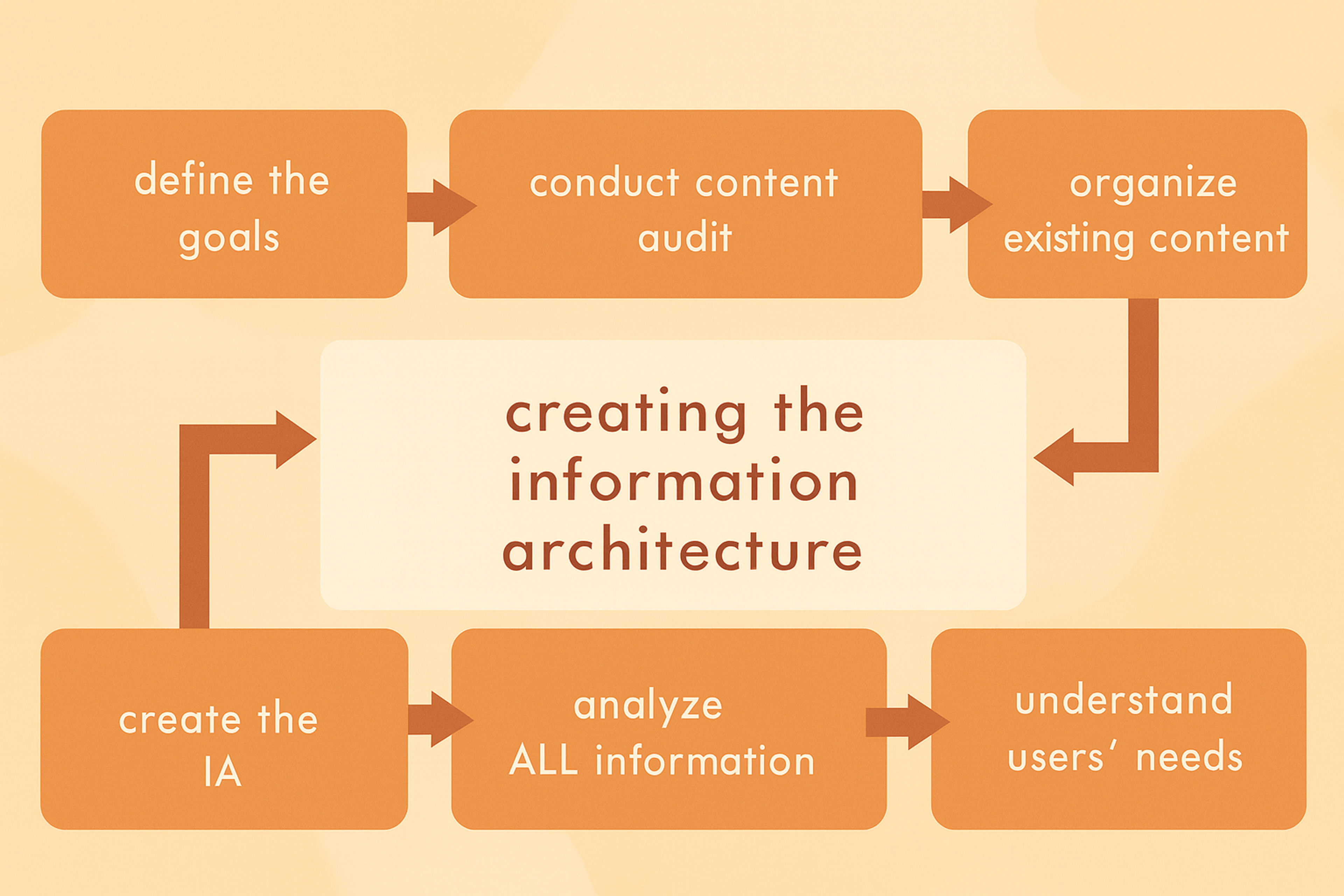
What Does an Information Architect Do?
An Information Architect (IA) designs the organization, structure, and labeling of content to improve the overall usability and findability of information on a website or within an application.
This means that an IA is primarily responsible for ensuring that users can navigate the product and access the information and tools necessary for completing their tasks in the most efficient manner possible. An information architect's responsibilities include understanding user needs and behaviors, which are crucial for creating structured and navigable information systems.
An IA performs user research to evaluate audience needs, creates a content inventory, designs an information architecture, and develops sitemaps or wireframes that depict content hierarchies.
They collaborate with UX and UI designers, content writers, and developers to ensure that the architecture meets user requirements and business goals. An incremental investment in the IA’s effort will maximize the impact of business-defined user-experienced products.
How Much Do Information Architects Earn?
Earnings for an Information Architect can vary due to their location, level of experience, education, and employment industry. Glassdoor has recorded that information architects in the United States will earn around $193k per year starting in 2025.
Depending on expertise and role demands, information architects' salaries are expected to be between $150k and $251k. The increasing focus on design and navigation for users in digital products is positioning Information Architects as some of the most sought-after professionals and best compensated.
Information Architecture Templates and Examples
Charity App
This intelligent assistant starts with an overview to walk users through the app's functionalities. Thereafter, users are welcomed with a landing page where they can log in via Facebook or email or set up an account if they haven't done so already.
After logging in, users will be taken to the main dashboard, which allows easy access to their bookmarks, messages, profiles, and new post creation. The design supports information architecture by providing consistency throughout the platform, leading to high user satisfaction.
Information Architecture Template
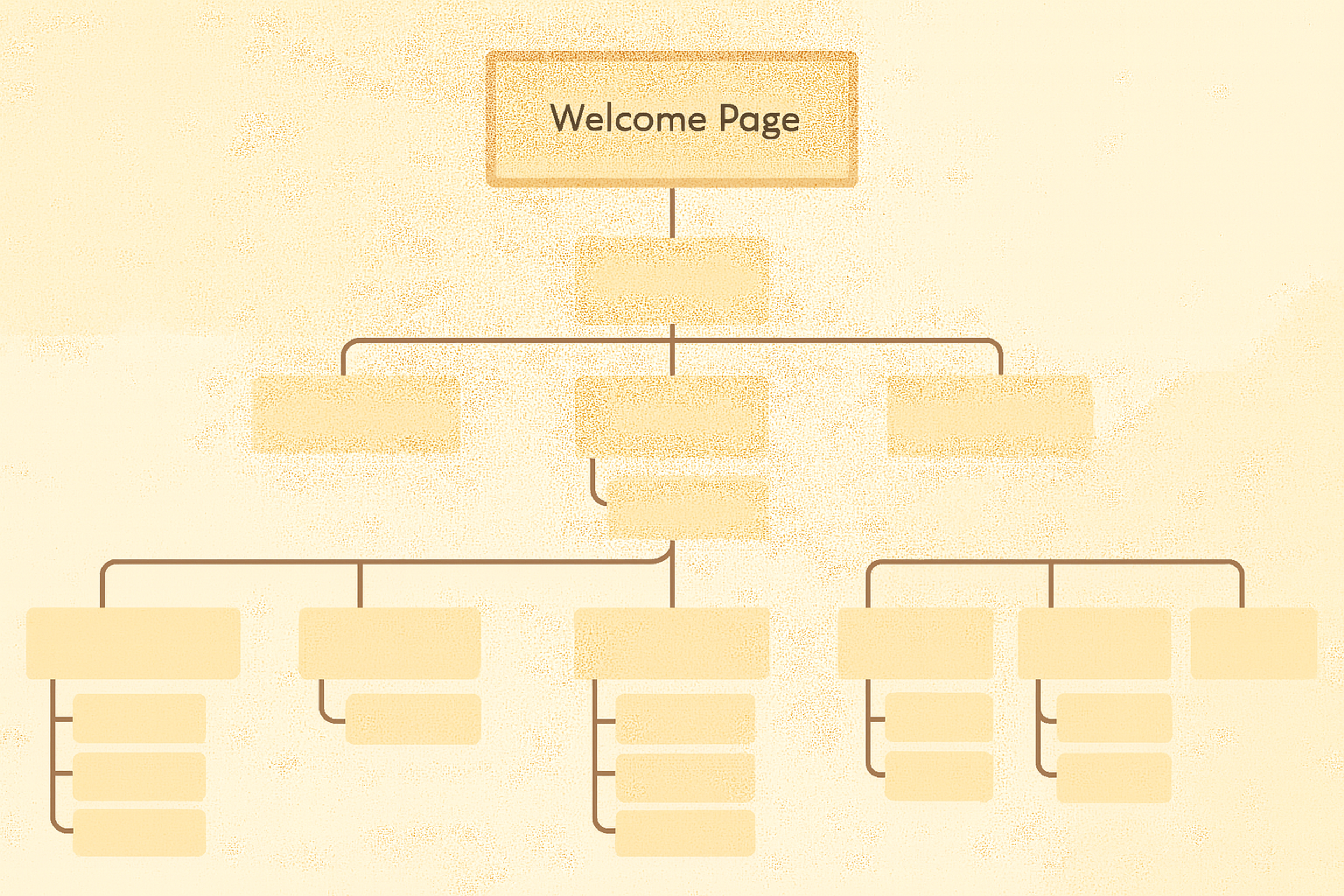
Visio Stencils
Nick Finck created this stencil set to aid in information architecture design. These universal tools are highly effective for designing wireframes, sitemaps, and process flows.
Stencils like these enable designers to clearly and systematically organize content. They also support information architecture by aiding in the design of digital products, making them organized and easy for end users to use.
The Museum
On the left side of the diagram, you see the various categories and subcategories that appear in the navigation header of the website. These were created to define information architecture that enables users to access important regions quickly. To your right are the various categories and subcategories in the website footer, which serve as additional user navigational elements.
This unique approach guarantees that sections that need to be accessed frequently are placed where they can be easily found while allowing access to other helpful material in a non-intrusive manner. The feedback about content is used to make these design decisions, meaning the design structures information architecture in a user-centered way.
The Museum Information Architecture Diagram Example
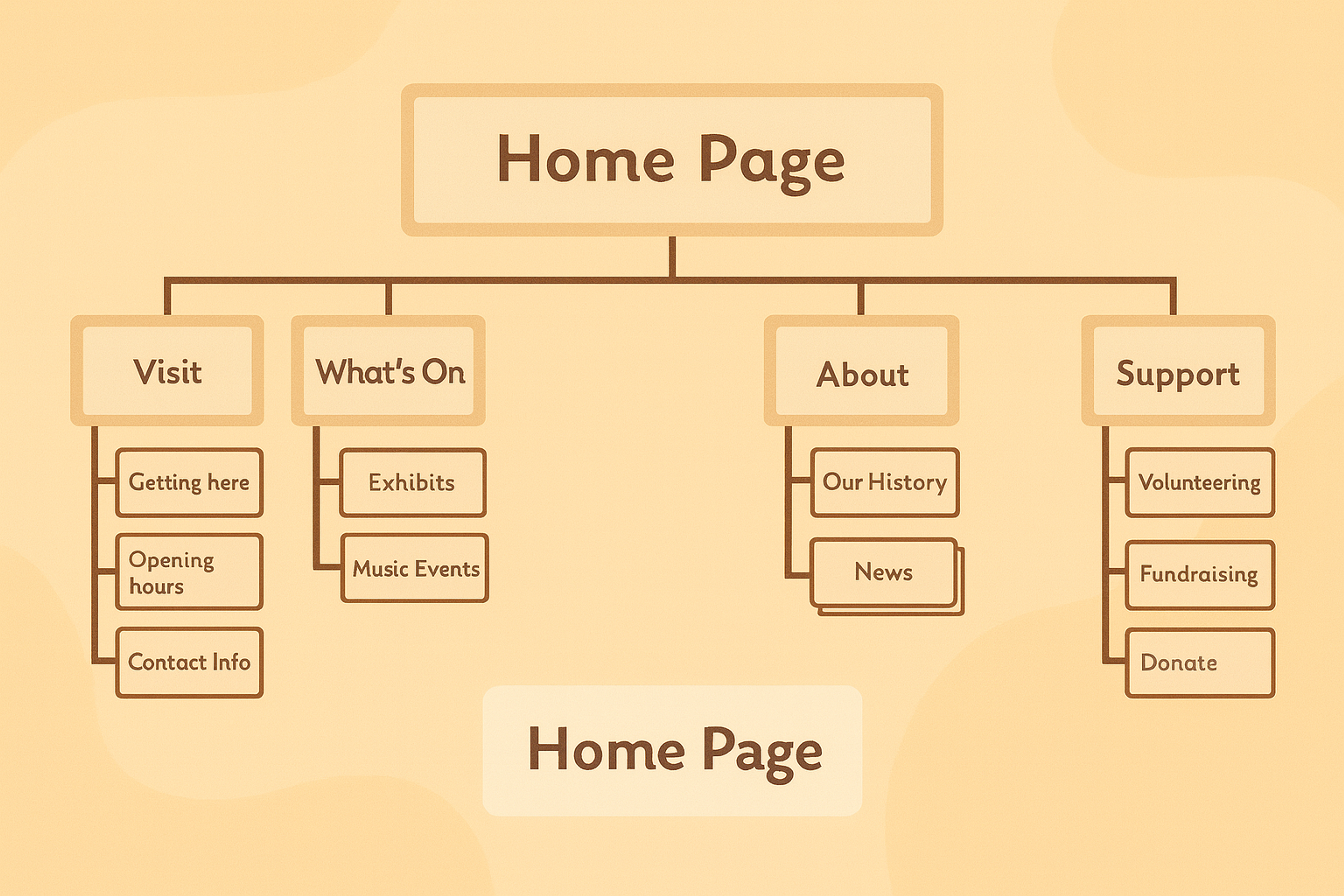
Tools and Techniques for Information Architecture
When it comes to information architecture (IA), using the right tools and techniques is essential to ensure content is organized intuitively, making it easier for users to navigate. These practices define information structure and help build clarity and usability into digital experiences.
Wireframing Tools
Wireframes are essential in IA for creating basic layouts and visual representations of a digital product’s structure. These wireframes help plan navigation and placement of elements before diving into design. Popular wireframing tool:
Sitemap Creation Tools
Sitemaps visually represent the structure of a website or app and how different sections relate to each other. Tool for creating effective sitemaps include:
Card Sorting
Card sorting is a technique used to understand how users categorize and organize content. It helps determine the most intuitive way to arrange information. Tool for conducting card sorting include:
User Research Tools
To build a solid IA, understanding your users’ needs and behavior is crucial. Tool that support user research include:
Prototyping Tools
Once the IA design is in place, prototypes can help visualize how users will interact with the system. Popular prototyping tool:
Collaboration Tools
Since IA involves close collaboration among multiple teams (designers, developers, and stakeholders), collaboration tool helps keep everyone on the same page:
Information Architecture Tools
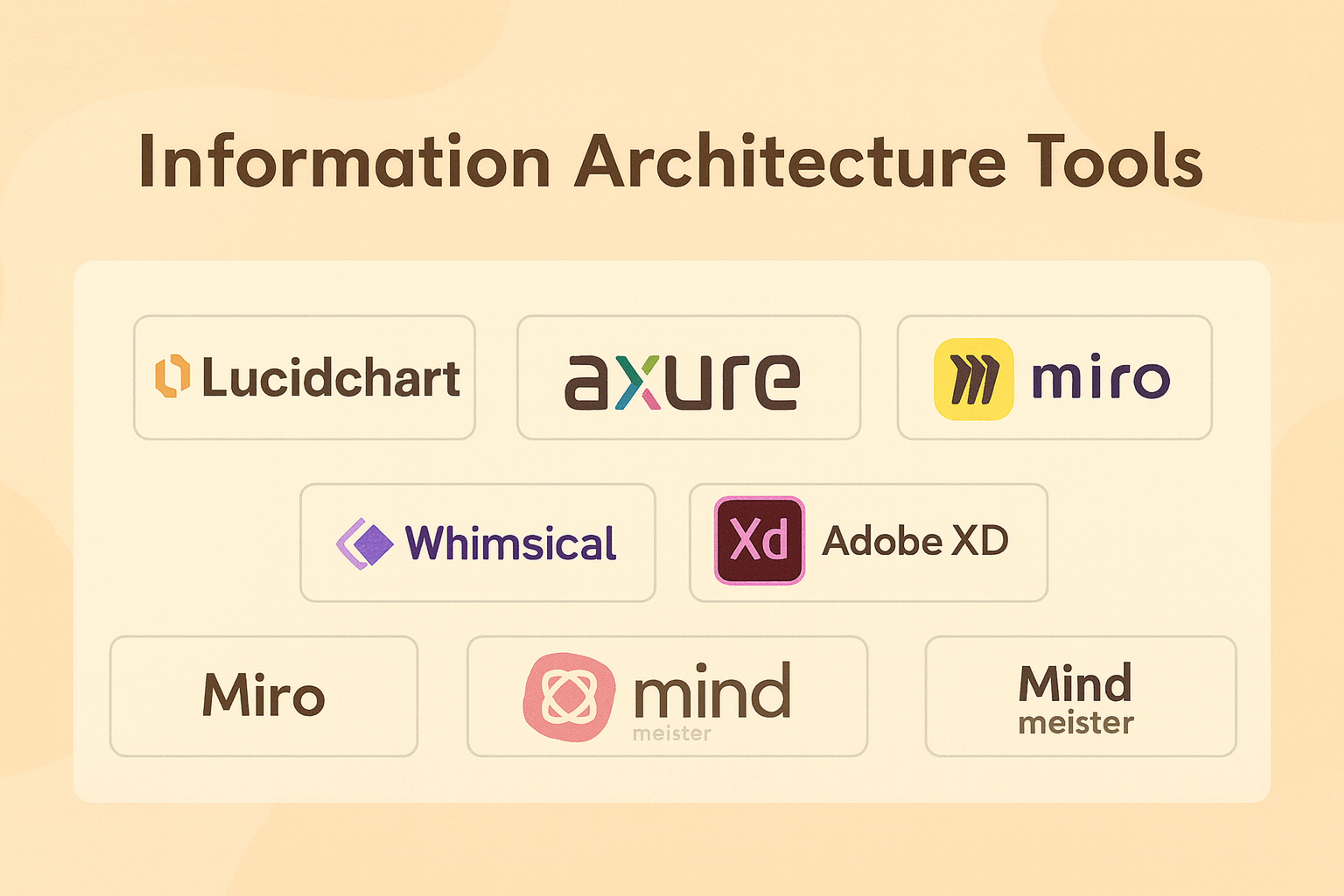
By using the right combination of tools and techniques, information architects can create well-organized, user-friendly structures that enhance the overall experience of digital platforms. These tools allow for efficient collaboration, research, and testing, ensuring the IA design is optimized for user needs.
FAQ
Is Information Architecture the Same as UX?
As noted before, Information Architecture (IA) is part of User Experience (UX) Design. Even though they are closely related, they are not the same thing. IA focuses more on a specific content's systemic components, content, and system. UX design is broad and distinct, considering content layout, visual design, interaction design, system usability, and user satisfaction.
While IA lays the groundwork for navigating a system by creating an order of framework, there are other factors besides courses of action that UX incorporates, such as aesthetics of designs and elements of interactivity, which make it the broader scope of the two.
IA is fundamental to UX because it provides the structure through which users interact with digital content. Still, there are other elements, such as aesthetics and interaction, that UX has to account for.
What Are Information Architecture Principles?
There are guiding principles for effective Information Architecture design. These include:
- Clarity: Content organizations should promote findings straightforwardly.
- Consistency: There is value based on uniformity as familiarity is built over time if labels, categories, and navigation are kept the same throughout the platform. Cognitive load is lessened as well.
- Flexibility: IA should allow for the addition of content and features.
- User-centric design: The user perspective matters in intuitive navigation and IA. Their goals, behaviors, and preferences directly influence navigation and interaction.
- Hierarchy: Manage information so that it follows a hierarchy that suggests its significance relative to other content and accommodates easier-to-locate venues.
- Findability: The system’s arrangement should make it simple to locate, sift through, and obtain the information.
Read more:
Conclusion
About UX design, Information Architecture (IA) is one of the core components in the design of digital products and services. By creating content or information structures that aid in adequately retrieving information, IA contributes to overall usability and user satisfaction. Understanding the basic principles of IA, such as clarity, consistency, focus on users, and extendability, helps in designing well-organized systems.
Appropriate IA helps in creating great experiences while navigating websites or using applications. With the right approaches and resources, UX designers can create information architectures that serve the users and the business requirements, crafting functional and stimulating digital interactions.


About Clay
Clay is a UI/UX design & branding agency in San Francisco. We team up with startups and leading brands to create transformative digital experience. Clients: Facebook, Slack, Google, Amazon, Credit Karma, Zenefits, etc.
Learn more

About Clay
Clay is a UI/UX design & branding agency in San Francisco. We team up with startups and leading brands to create transformative digital experience. Clients: Facebook, Slack, Google, Amazon, Credit Karma, Zenefits, etc.
Learn more


